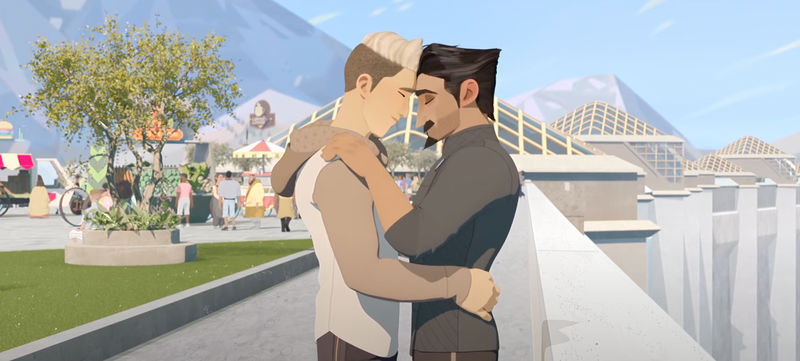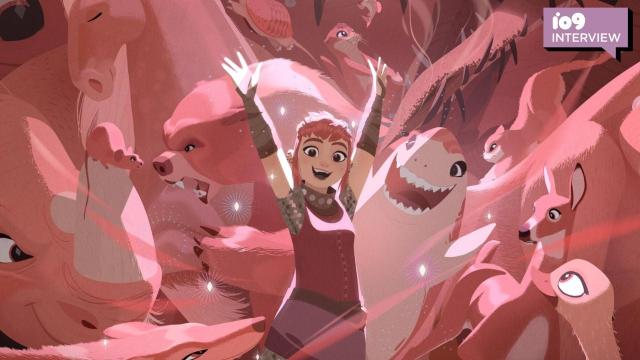Cinema’s annual awards race comes to a close today during the Academy Awards, and there’s no other story like Nimona’s journey to becoming a nominee in the Best Animated Feature category.
Producers Karen Ryan and Julie Zackary sat down with io9 to tell this remarkable tale of second chances. After Nimona’s original studio, Blue Sky, was closed during the Fox-Disney merger, the project found a new home at Annapurna Animation and Netflix, defying all odds. The film is based on the award-winning graphic novel by ND Stevenson, which now has legions of new fans thanks to this widely accessible adaptation, and resonates with so many for being authentic to the trans experience and telling an earnest LGTBQ+ narrative.
Sabina Graves, io9: Let’s talk about the adaptation of the graphic novel. What made you want to sign on to bring it to life?
Karen Ryan: This is my favorite question to answer because I discovered the graphic novel and loved it immediately. When the opportunity [came] to go to Blue Sky to make it happen, I grabbed it. I moved across the country to do it because I have never seen a character like Nimona in animation before, and that’s saying a lot, because I’m very proud of all the films that I’ve made and all the movies that have come out recently. But for me personally, what drew me [in] was she is this strong character who knows who she is, and she’s not apologizing for it and she’s not trying to find herself. I related to that so much. The graphic novel has such a devoted fan base, because people see themselves in all the different characters, and you don’t you don’t find that very often. It’s a very, very cool thing.
Julie Zackary: I came over to be the head of production when Disney was revamping Blue Sky studio, and I heard about Nimona from my colleagues. In fact, Karen, I think on my interview you gave me the book. My son read it and loved it—and I immediately fell in love with not only the content, but the people who were making it, and knew that we had something really special.
io9: This project has had such a long journey, with being at Blue Sky during that tumultuous era of the takeovers. I want to know, through all of that, what was the reasoning behind continuing to champion this project when things started to fall out of alignment and ultimately ending up where it was meant to be?
Ryan: When Nimona came to the studio, there was something we did that was a little bit different. We opened up the story conversation to everybody in the building. We knew that this novel was speaking to people and we wanted to hear everyone’s different stories. So we invited people in. We started with one meeting, and that immediately branched into a week’s worth of conversations that we had, because people were finding themselves so clearly represented in this film. Specifically members of the LGBTQ+ community. And once we unlocked that there was never a question that we needed to make this film happen.
So [while] in development at Blue Sky, before the merger happened, before we were shut down, this film was taking on this life of everyone rallying behind it in the studio. People were working on different projects at the same time, but everyone was coming to Nimona—and it just gained this life and the story became the stories that we were hearing in these conversations. We had to make this movie. There’s characters and themes in this movie that you don’t see typically in kids and family entertainment, and that needs to change. So that was driving us through all of the change.
Zackary: During covid, Disney was hemorrhaging money, so they of course chose to close the third and redundant animation studio. During the time we were given a chance to try to find a new buyer for it. And at first, and when that didn’t work, we pivoted quickly to trying to save the movie because none of us had really been expecting something like Nimona to come through and touch us so deeply. We had this reel that was incredible, that had been put together and that was basically ready to go. I don’t even remember there even being an option, I think—because we were in fight mode to try [and] save the studio, we still were like, “Well, of course we can save this movie.” And we all connected to it so deeply. We literally turned from filmmakers into film sellers. We had no idea what we were doing. We called in every favor. We called in other studios to get advice. We called colleagues from other places to get advice. We had called relatives. We had called bankers. We had basically picked up the phone to anybody who would listen, shared the reels, and said, “How do we do this?” Nobody knew what we were doing—there was no playbook to follow. We, just on the strength of the reels and really our audacity to really have the nerve to think that we could do this, found a way.
When we had come across Annapurna and Megan Ellison, she immediately connected with the reel, [and] said, “I needed this movie when I was younger. This is a no-brainer for me. Of course. What do you guys need to make this movie?” And then without even blinking, we were now in production as an independent studio with Annapurna. Instead of a big studio like Fox or Disney or Blue Sky, where we had tons of support, resources, and departments to try to make this movie, now it’s me and Karen trying to figure out how to schedule an orchestra and what to do about records during covid and how to find a casting person. So we had immense support from Annapurna and then eventually Netflix—but we quickly had to learn that we were on our own, and it was pretty liberating. But also, in retrospect, I look at what we did… we were bonkers.

io9:It’s really badass, though, to be real.
Ryan: We naively just wouldn’t give up. And I think that kind of helped us keep moving forward; [we] didn’t actually fully grasp how difficult this was going to be. We just knew we couldn’t stop. There’s so many projects are canceled all of the time for lots of different reasons. So we’re definitely not the first company film to go through this. But for all of us, it was just so personal and we saw our crew put themselves into this. We just put our heads down and didn’t take no for an answer and just kept trying.
io9: Can you share a bit about how Nimona stands as a success story during the current state of animation, when lots of projects keep getting shelved, and how it motivates you to take more chances?
Ryan: For as many doors that were closed and no’s that we got, [and all the] uphill challenges trying to get this movie through—we met so many people throughout this industry that wanted to help. We’re here because everybody that we met and all these individuals and people within companies wanted the movie to succeed. And they put themselves into it. So while it’s a weird time for animation right now, it’s a strange state for the whole industry, what gives me a lot of hope is how many people I saw put themselves into this and then come and carry us when we needed it, because they want this kind of content and they wanted this movie to happen. That to me means there’s a bright, bright future. If everybody keeps doing that for the projects that they feel need to see the light of day, and deserve to be out there, and are needed by the community and represent people who need to see themselves on screen—we can do it because we literally just did it. And I want to see more of that. And I think we’re going to.
Zackary: To add to that is, is Netflix has been an amazing partner the whole way. Making this movie and distributing this movie—and it is sometimes a little difficult, you know, to understand how to find movies on Netflix because your algorithm basically understands your tastes and things like that. So what seemed to be happening was not tons of people could find Nimona, and it might have been because they didn’t want animation or they don’t understand that animation isn’t just for kids. Animation is film.
So when the when the film was uploaded onto Netflix’ YouTube last week, the first three days of comments, I mean, we would carry on. We’re watching that the reviews tick up from like 100,000 to 200,000 to 500,000—and we’re like, “Oh my god. Like these people are like really responding to this.” The comments were incredible. They were like, “Where did this come from?” “Thank you Netflix.” What that ended up doing was creating a space where everybody could watch it, and you didn’t necessarily have to be behind a paywall to in order to find it. And [to see] the love and support for the movie and the people who are connecting to it—people who are like, “Wow, that was a surprise. Netflix released a movie and it was good.’”
io9: That’s so awesome. I just hope that more people discover the film as time goes on. And I wish you all luck during the Oscars. It’s going to be a big week for sure!
Need more entertainment? Pedestrian Television has launched on 9Now where you can watch iconic TV series like Just Shoot Me, cult classic movies like Fright Night, and homegrown content like Eternal Family. Watch all that and more for free, 24/7 on 9Now.
